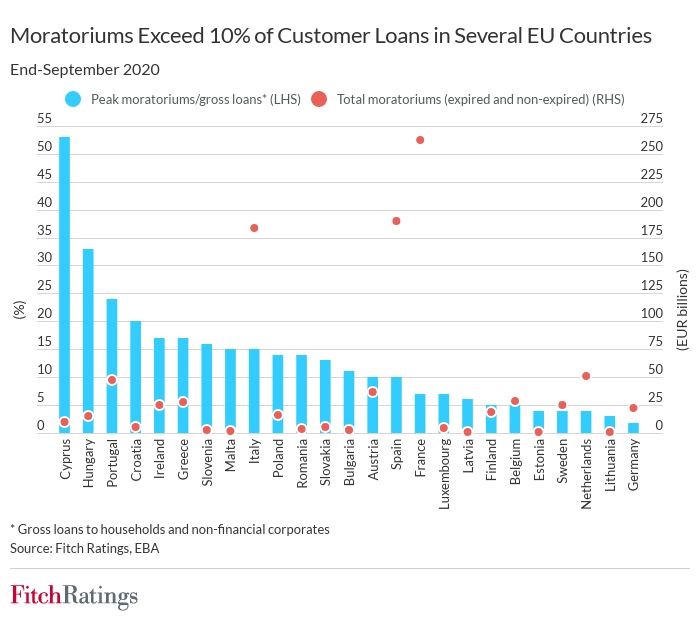Eurozone Banks' Asset Quality is ECB's Main Concern for 2021
Source: Fitch Ratings
Eurozone banks' asset quality is the ECB's main concern for supervision in 2021 after the correlation of borrower default rates to macro-economic shocks fell below historical levels in 2020, Fitch Ratings says. This was due to unprecedented public support measures, including monetary, fiscal, regulatory and supervisory actions, which will start to wane in 2021.
The ECB's expectation that eurozone banks' impaired loans will increase in 2021 as the true economic impact of the coronavirus pandemic becomes clear is in line with our 2021 Outlook for Western European Banks.
The second wave of the pandemic triggered renewed restriction measures in 4Q20 and early 2021, which will further affect EU economies and the credit quality of many corporate and individual borrowers. The ECB issued credit risk recommendations to most (80%) of the 115 significant banking groups it supervises in December 2020, which will likely lead to additional provisioning in 1Q21.
The ECB is particularly focused on loan moratoriums, which mask borrowers' financial difficulties. It recommends banks to differentiate between obligors with temporary liquidity shortages and those with deeper credit problems. Suspensions of loan instalments (interest, principal or both) have been widely used, implemented through legislation or on a voluntary basis. More than 10% of gross loans to households and non-financial corporates across 13 EU countries had benefited from moratoriums at end-September 2020.

We expect the vast majority of moratoriums to have expired in 2020 or by end-1Q21, particularly given the nine-month cumulative duration cap for moratoria extension after 30 September 2020, introduced by the European Banking Authority (EBA). Banks exceeding the cap must classify loans with renewed payment suspensions longer than nine months on a cumulative basis since March 2020 as forborne (Stage 2 under IFRS 9, reflecting a significant increase in credit risk) or unlikely to pay (Stage 3).
About 85% of loans under moratorium had payment suspensions extended to end-2020, according to EBA data at end-June 2020. Since then, moratoriums have been extended into 2021 in some countries, including Italy (where banking associations are lobbying for further prolongation) and Portugal. Some sectors, such as hotels, restaurants and entertainment, are likely to need extended support throughout the EU.
On average, about 20% of loans complying with EBA moratorium guidelines (and therefore eligible for favourable regulatory treatment) were classified as Stage 2 at end-September 2020. This is more than twice the proportion of total loans classified as Stage 2 (8%). However, Stage 3 classifications among loans under moratorium were comparable to the levels in the overall loan book (3%). The ECB is concerned by this as it would have expected a higher percentage.
The ECB has kept banks' Pillar 2 requirements (P2R) and guidance (P2G) stable for 2021, except where changes are justified by exceptional circumstances, for example for banks that recently came under its direct supervision. P2R remains at 2.1% and P2G at 1.4%, on average, for 2021. P2G will be updated following the 2021 EU-wide stress test, coordinated by the EBA.
Nine banking groups under the ECB's supervision made use of the possibility to operate below the P2G at end-September 2020. The ECB encourages banks to consume these buffers to recognise asset-quality issues quickly. It also allows banks to make use of the capital conservation buffer (2.5% of risk-weighted assets). The nine banks concerned were not named, but we expect they are mostly in southern Europe.
The ECB, like Fitch, expects the rebound in banks' profitability this year to be modest, due to further loan impairment charges and continued pressure from low interest rates. It therefore encourages banks to improve their operating efficiency to give more room for loan provisioning.

















































First, please LoginComment After ~